![]()
Introduction
Texts
Illustrations
This page is also available in French
![]()
Though not one of Paris’ major concert venues in the 19th century, the Salle des Concerts Herz, or Salle Herz for short, played nevertheless a significant part in Berlioz’s musical career in Paris. The hall took its name from its founder, the pianist Heinrich Herz (1803-1888), a talented musician who enjoyed a long and successful career in Paris and throughout the musical world of the time (see his obituary notice below). Born in Vienna in 1803, and thus an exact contemporary of Berlioz, Herz studied first in his native Austria; he soon moved to France where he acquired French citizenship, changing his first name from Heinrich to Henri, and thereafter Paris became the centre of his career (compare the case of Charles Hallé down to 1848). Herz studied at the Conservatoire which he first entered in 1816, won a first prize in 1818, and was later professor of piano there from 1842 to 1874. Together with his brother Jacques he also founded the École spéciale de piano in Paris. Among his many disciples were pianists who were later close friends of Berlioz, among them Louise Massart and Marie Jaëll. One of the most sought-after pianists of his time, Herz was a prolific composer of piano music. He also became involved in the business of piano-making and founded a factory of his own; he entered instruments for the Exhibitions in Paris in 1844 and in 1855, where he was awarded a medal of honour.
It is not known exactly when Herz and Berlioz first met, but in the world of the time it did not take long for musicians in Paris to get to know each other. At any rate Herz is first mentioned by Berlioz as a pianist in a feuilleton of late 1840 (Journal des Débats, 23/12/1840, p. 2;; Critique Musicale IV p. 409: ‘his talent is justly celebrated’). Thereafter Berlioz frequently refers to the numerous concerts given by Herz in Paris (see for example Journal des Débats 27/1/1852; 17/3/1853; 26/1/1855), and he also mentions his tours abroad (Journal des Débats 27/8/1850 on his trip to the United States and Mexico, and 30/9/1851 on his return). He also refers several times to Herz as a manufacturer of pianos in connection with his participation at the Exhibitions of 1844 and 1855 (Journal des Débats 23/6/1844; 12/1 and 15/1/1856). Whenever Berlioz mentions Herz, whether as pianist, teacher, composer, or manufacturer of instruments, the tone is friendly and positive, and shows also on occasion a touch of light-hearted humour (as in the reports on Herz’s travels across the Atlantic, or the comments on his success as a teacher with young women in the Journal des Débats of 19/11/1862). Herz was evidently an easy-going and pleasant man for whom social success came naturally. Very little is preserved of his correspondence with Berlioz, which is hardly surprising. They never were close friends, and as both resided in Paris they had in any case many opportunities to meet. Allusions in Berlioz’s letters imply that Berlioz continued to see Herz from time to time in his later years (cf. CG nos. 2763 in 1863, 3303 in 1867). In one letter Herz reminds Berlioz of a promise to review a concert of his (CG no. 2544, 17 March 1861) and Berlioz duly obliged in a feuilleton the following month (Journal des Débats 7/4/1861). On the occasion of the death of Berlioz’s son Louis Mme Herz wrote to him a heartfelt letter of condolence on behalf of herself and her husband (CG no. 3257, 2 July 1867).
The name of Herz was also associated with a concert hall which he opened to the public on 12 December 1838: his intention was no doubt in part to provide himself with a suitable venue for his own concerts, but the hall would also be attractive to all musicians in Paris interested in putting on concerts on a smaller-scale. The precise occasion was announced in the weekly journal Le Ménestrel (9/12/1838, p. 3):
M. Henri Herz will give a large Inaugural Concert on Wednesday evening [12 December] in the new hall which he has just built at his own domicile. Apart from several new compositions by M. H. Herz, Messrs. Lafont and J. Herz [brother of the pianist] and Mlle Bertuccat will be heard. The vocal pieces will be performed by Mmes Perugini, Placci, Drouart and Laty and by Messrs. Masset, Perugini and Ruggiero. For tickets apply to M. H. Herz’s address at 38 rue de la Victoire and to music dealers.
It will be noted that the address is given as 38 rue de la Victoire, which agrees with a letter of Berlioz of 1844 concerning his projected use of the hall for the concert at which the overture le Carnaval romain was premièred (CG no. 879, 18 January). Evidently the houses in the street were subsequently renumbered, as the address of Salle Herz is given later as no. 48 (see the poster below for the first performance of l’Enfance du Christ in 1854). A week after the initial announcement Le Ménestrel gave a short review of the inaugural concert (16/12/1838, p. 3):
Last Wednesday M. Henri Herz inaugurated his fine concert hall at rue de la Victoire. The whole audience admired the lavish decoration of the building and the convenient seating arrangements. Messrs. Herz and Lafont and Mlle Bertuccat made the greatest impression. The vocal part of the programme was less remarkable, though Mlle Drouart and Mme Laty received deserved applause. If M. Henri Herz does not fix the price for hiring the hall too high, we can guarantee that this charming hall will attract a lucrative musical clientèle.
The hall was indeed an immediate success. Berlioz’s first mention of a concert there is in a feuilleton of 1839 (Journal des Débats 22/3/1839, p. 2; Critique Musicale IV p. 46), and there are numerous similar mentions in subsequent articles throughout Berlioz’s career as a music critic down to 1863 (see for example Journal des Débats 16/4/1845). But the hall had its limitations, as Berlioz mentioned already in 1841 (Journal des Débats, 14 February 1841) and then explains at length in a feuilleton of 1847 (Journal des Débats 14/2/1847, p. 1; Critique Musicale VI p. 290):
The dimensions of concert halls stand in general in proportion to the love which the public is assumed to have for music, and their internal layout is dictated by the kind of music that is meant to be played there. Hence we do not have in Paris a large concert hall. We have banqueting halls, halls for balroom-dancing, halls for drawing lots for military conscription etc., but we do not have a single concert hall worthy of the name that is available for hire when required. Hence the impossibility of getting certain compositions performed, if theatres are unable or unwilling to change themselves into concert-halls, particularly during the winter season, where the exclusive privilege of using the hall of the Garde-Meuble de la Couronne [the royal storehouse for furnishings], which is already very small, is granted to the Société du Conservatoire. A few years ago M. Herz built a concert hall which is excellent for concerts on a modest scale, that is to say those where virtuosi or singers perform accompanied by a piano or a small orchestra. But apart from the fact that the stage is not well suited to seating a body of 40 musicians, it is quite impossible to place on it a large-scale modern orchestra; still less should one think of introducing there a real chorus. As the city of Paris is not musical enough to finance the construction of a suitable and worthy hall, we should therefore be thankful for having that of M. Herz, but for the fact that repeated experience has demonstrated that this hall, too small for large-scale concerts, is at the same time too large for the small public which is attracted by concerts on a modest scale. It can seat an audience of 800… Now how, except in the case of free concerts, is it possible to gather an audience of 800 for a concert by a violonist, a pianist or a singer?… This is the point that M. Sax has grasped when he built his new hall. It is half the size of that of M. Herz. It goes without saying that it is only possible to accommodate there the embryo of an orchestra, but at least there are no more than 400 seats available for the public; this will make it possible to see it occasionally filled to capacity when a very famous virtuoso of extraordinary talent comes to perform there. It has a good acoustic, is well decorated, easy of access, located in the best part of Paris, and can be hired for a very modest price.
Adolphe Sax was the celebrated instrument-maker whom Berlioz supported throughout his career. His concert hall was at no. 10 rue Neuve-Saint-Georges, which is where his factory was also located. The figure that Berlioz gives for the seating capacity of the Salle Herz (800) is too high: it was clearly rounded up to contrast it with the smaller Salle Sax. In a letter to the violinist Prosper Sainton concerning a concert that Sainton wanted to give in Paris with his fiancée Charlotte Dolby, Berlioz gives, from his own experience, the detailed breakdown of the costs involved in hiring the Salle Herz for a concert, and gives the capacity of the hall as 600 (CG no. 2081, 16 January 1856, cf. 2082). The exact figure was 668 (according to Critique Musicale VI p. 290 n. 12). In other letters Berlioz expresses his frustration with the limitations imposed by the size of the hall, which affected both the scale of the concerts he could give there and the size of the audience. ‘I am giving a concert here on 25 January [1856] in Herz’s hall; his is the only one available to me. When you use a chorus there it is almost impossible to have at the same time a full-scale orchestra. I can get away with it with l’Enfance du Christ, because this score only has 2 horns, but no trumpets or cornets, only 2 bassons, no ophicleid and no percussion instruments’, he writes to Liszt (CG no. 2074, 31 December 1855; short parts for cornets and trombones were actually added later). In a letter to Auguste Morel not long after he laments: ‘As for the Parisians they are always the same: an inert and ice-cold mass, and the small public of Salle Herz has so little power that its influence is virtually nil’ (CG no. 2077, 9 January 1856). In spite of it all Berlioz did make use of the hall as it was more easily available (after 1843 Berlioz was in practice debarred from making use of the Conservatoire). It came in very handy in 1844 when he needed a venue for sectional rehearsals for his large concert for the Festival of Industry on 1 August (Le Ménestrel 21/7 and Journal des Débats 23/7), and again the following year for his concerts at the Cirque Olympique (CG no. 944, 22 February).
It was in fact at the Salle Herz that two of Berlioz’s works received their first performance, the Carnaval romain overture and his oratorio L’Enfance du Christ.
The Carnaval romain was first heard at a concert on 3 February 1844. Extant is a letter of Berlioz to J.-L. Heugel, the publisher of Le Ménestrel, in which he asks him to print an announcement for that concert, which Heugel duly did a few days later, reproducing almost word for word the text of Berlioz’s letter (CG no. 879, 18 January 1844; cf. Le Ménestrel 21/1/1844 p. 4). A week after the concert Le Ménestrel published a complimentary review of the occasion, which is reproduced in translation below. The performance of the overture was given after only one rehearsal but was nevertheless a great success: the work was encored. Berlioz refers to the occasion in his Memoirs (chapter 48; the account had already appeared in Le Monde illustré of 7 May 1859); it was also mentioned years later by Charles Hallé, though he seems to conflate two different concerts that were a year apart, and his statement that the performance was given without any rehearsal is inaccurate, as comparison with Berlioz’s own account shows (cf. also CG no.881).
The first performance of L’Enfance du Christ took place at Salle Herz on 10 December 1854 under the composer’s direction; the work was an immediate success (cf. CG nos. 1843, 1844, 1846, 847, 1848, 1851 and the review by Léon Gatayes in Le Ménestrel of 17 December). As a result Berlioz repeated the work in the same hall twice not long after (24 December 1854 and 28 January 1855). This was soon followed with performances abroad, one in Weimar (February 1855) and 3 in Brussels (March 1855), and more were to come later in Paris and elsewhere, including an unusually large-scale performance in Strasbourg in June 1863. There is little doubt that the success of the work with the Paris public contributed significantly to Berlioz’s election to the Institut in June 1856. The original choice of venue had been dictated by practical considerations: the Salle Herz could accommodate a choral work that required only modest forces, as the letter to Liszt cited above shows (CG no. 2074).
![]()
![]()
![]()
The Salle Herz continued in regular use for many years, at least down to 1885. In 1886 it was temporarily closed for repairs (Le Ménestrel 11/4/1886, p. 151), but after it was reopened it seems from scanty references to it in Le Ménestrel to have been used much less frequently than before. There was also competition from a similar hall named after a different Herz (the Salle Philippe Herz), which had been opened at a different address in Paris early in 1885 (Le Ménestrel 4/1/1885, p. 39). At some point the original Salle Herz was demolished, but we have not been able to establish the exact date.
Herz himself died in early 1888, outliving his contemporary Berlioz by almost two decades; his obituary notice in Le Ménestrel is reproduced in translation below. After his death his widow founded an annual piano prize named after him for the best woman student of the year in what had been his piano class at the Conservatoire (Le Ménestrel 7/7/1889, p. 224). Two years later she sold the Herz piano business to another piano manufacturer in Paris, the firm of Amédée Thibout & Co. (Le Ménestrel 12/7/1891, p. 224).
![]()
![]()
![]()
![]()
Le Ménestrel 11/2/1844, p. 1-2: review of the concert on 3 February 1844 (unsigned)
[English translation from the French originals by Michel Austin]
Let us deal first with M. Berlioz’s concert, which was given on Saturday 3rd of February. Everything here was grandiose and frequently excentric. But this time the success of the concert’s beneficiary was so manifest that we cannot but add our own voice to the enthusiastic clamour of the entire hall.
Yet M. Berlioz’s concert was unable to protect itself against the influenza and colds which are currently afflicting the singing fraternity. Mme Nathan was due to sing several pieces from Alceste, but in her place Mme Dorus came to sing the romance from Robert-le-Diable and the aria from Charles VI; Mme Beausire was due to perform a scene from Faust [i.e. the Huit scènes de Faust], but the strains of Hérold had to be substituted to the lament of Marguerite. It may be said that nothing was lost from the change, and that more than adequate compensation was provided. — We do not share this view; wonderful as is the voice of Mme Dorus (she was in fact altogether delightful), and inspired as the strains of the Marche des pélerins may be [from Harold en Italie], we would have preferred the excerpts from Gluck’s opera, and especially the scene from Faust, which is unknown to us. That will be for another occasion.
Mlle Recio gave a talented performance of Absence, a melody which, as rendered by Duprez, breathes such charm [at a concert at the Conservatoire on 19 November 1843]. — The bal from Roméo et Juliette, the love scene, and especially the Scherzo of Queen Mab made their customary effect, that is, they were received with rapturous applause. We hear this wonderful symphony all too rarely; is M. Berlioz not thinking of indulging us by giving the symphony complete, and not only in excerpts? — We have little to say about the ballad entitled Hélène; it seemed to us monotonous and ineffective, but perhaps the piece needs to be heard several times; the performance also was far from revealing it in the best light. — A beautiful hymn of great character, specially composed for instruments either invented or perfected by M. Sax, caused as much surprise as delight. The brilliant sounds, the instrumental voices which blend so well despite the variety of their timbre, all this surprised the public greatly and then delighted it. The bass clarinet and the saxophone were particularly admired; a few passages played solo by the last-named instrument enabled listeners to appreciate its roundness of tone, evenness, power and majestic solemnity. The victory won by M. Sax that evening is a better answer to all his detractors than all the articles and explanations in the world. — We have kept for the final bouquet the overture Le Carnaval romain, composed on music from Benvenuto Cellini. Much as we admire the first overture which bears the title of this opera, we are forced to admit that this new one leaves it far behind, and it seems that the audience shares our view, to judge from the frantic applause and the countless shouts of bis which greeted it. It is impossible to describe adequately the poetic melancholy of the cantabile, and the mad exuberance of the allegro; these are effects that can only be appreciated once you have heard them. In this piece you hear the sighs and laments of love, the ringing delight of timbrels, and everything overflows with passion and fantasy. Berlioz has often been as warm, as dramatic, and as original as he is here, but never have we encountered such clarity and sense of completeness. The first trio is borrowed from the fine trio of the first act; as for the second, we do not know from which passage of the opera it is taken [in fact from the Carnival scene in act I]. M. Berlioz’s concert will leave behind long and brilliant memories. For our part, we are anxious to see the return of such a musical treat.
Le Ménestrel 8/1/1888, p. 16: Obituary notice for Henri Herz.
It is with deep sadness that we record the death of a remarkable artist who for nearly half a century has held an important and almost exceptional place among us. Henri Herz, the distinguished pianist, the elegant virtuoso, the prolific composer, who from 1830 onwards was the lion of Paris concerts, died last Thursday [5 January] at the age of 84, leaving behind an excellent memory to all those who were able to know and approach him. Herz was born in Vienna in 1803 [on 6 January]. He was taught in his native country by his father and by Hunten, and by Pradher at the Paris Conservatoire, and as is well known, his career was brilliant and constantly successful. We will not attempt to outline it here or to recall his travels, his triumphs and the plaudits which he received everywhere, not only in France, nor even in the whole of Europe, but as far as America, where he aroused indescribable enthusiasm. A distinguished artist in every respect, Herz was also a much sought-after teacher, and it is known that his class at the Paris Conservatoire has produced a large number of remarkable students. He had given up his teaching since 1874, after publishing a few years earlier, under the title of My Travels in America (Paris, Faure, 1866), a rather intriguing account of his travel impressions, which had previously appeared in the columns of the Moniteur universel. It will be known that this very active and hard-working artist founded at one time a piano manufacture which soon developed on a large scale and carried his name to the old and the new world. As a composer he leaves behind no less than 200 works of every genre, consisting of concertos, varied airs, fantasias, transcriptions, studies etc., which enjoyed in their time truly prodigious success. In many respects Herz has been one of the most remarkable and most noticed artists of the first two-thirds of this century. — The funeral ceremony took place on Saturday [7 January] at the church of Notre-Dame-de-Lorette, where our great singer Faure sang the Pie Jesu. A large crowd of notables from the world of music was in attendance.
![]()
Unless otherwise specified, all the photographs reproduced on this page were taken by Michel Austin; other pictures have been scanned from engravings and other publications in our collection. © Monir Tayeb and Michel Austin. All rights of reproduction reserved.
The following three pictures of Henri Herz are courtesy of the Bibliothèque Nationale de France, Paris.
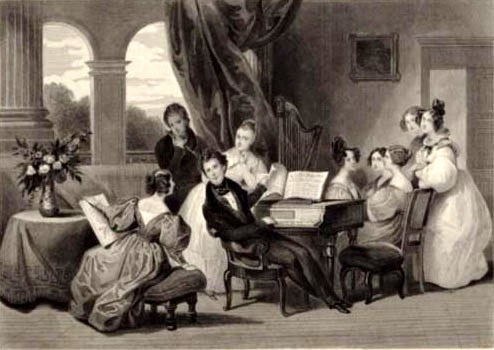
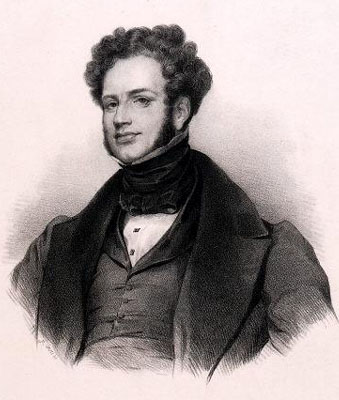

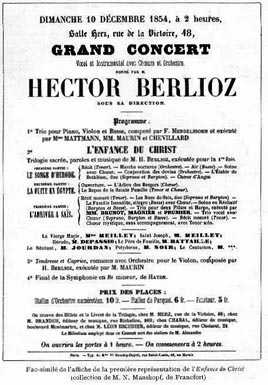
We are most grateful to our friend Gene Halaburt for sending us an electronic copy of a facsimile of the billboard of the 1854 concert, which is reproduced above.
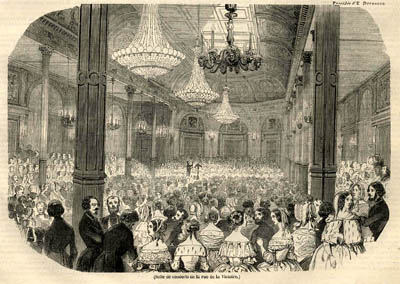
The above engraving was published in L’Illustration of 10 June 1843, a copy of which is in our collection.
A related article in the paper, entitled “Salle de concerts de la rue de la Victoire” gives some details of the interior of Salle Herz:
“Henri Herz, the talented and famous pianist, is the owner of this hall, which he had built a few years ago. It is very different from the hall of the Conservatoire, the extreme simplicity of which we once had occasion to point out. Salle Herz, by contrast, is brilliant, sumptuous and altogether fashionable; it is decorated with bright paintings, enveloped with elegant undulating arabesques; gold glitters in every corner, lit up by a thousand candles… But Heaven preserve me from attempting to describe it in words! To give the reader a complete idea, l’Illustration has means far more telling than the most exact and detailed description.
In this richly and elegantly decorated venue the élite of Parisian society thus gathers every winter whenever an artist from France or abroad comes to seek its approval.”
The writer of the article then names a few eminent artists who had performed in the Hall; he ends the article with a detailed review of a musical performance which took place there.
[English translation of the French original by Michel Austin]
The photographs reproduced below were taken by Michel Austin.
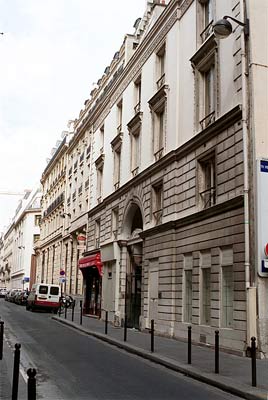
No. 48 is the second building on the right.

No. 48 is the second building on the left.
![]()
© (unless otherwise stated) Monir Tayeb and Michel Austin for all the pictures and information on this page. This page was revised and significantly enlarged on 1 August 2013 and 1 November 2016.
Copyright notice: The texts, photos, images and musical scores on all pages of this site are covered by UK Law and International Law. All rights of publication or reproduction of this material in any form, including Web page use, are reserved. Their use without our explicit permission is illegal.